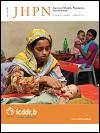Trends in Choosing Place of Delivery and Assistance during Delivery in Nanded District, Maharashtra, India
DOI:
https://doi.org/10.3329/jhpn.v29i1.7568Keywords:
Community-based studies, Cross-sectional studies, Descriptive studies, Delivery, Rural health services, IndiaAbstract
Delivery in a medical institution promotes child survival and reduces the risk of maternal mortality. Many initiatives under the National Rural Health Mission (NRHM) focus on increasing the institutional deliveries. This study describes the trends in choosing place of delivery in Nanded district at the end of the first phase of the mission. Key informants were interviewed to document the initiatives under NRHM implemented in the district. A cross-sectional descriptive study was conducted in 30 villages selected using one stage cluster-sampling method. A house-to-house survey was conducted in June 2009. A set of structured open-ended questionnaire was used for interviewing all women who had delivered during January 2004–May 2009. The outcomes studied were place of delivery and assistance during delivery. Analysis was done by calculating chi-square test and odds ratio. Interventions to improve the quality of health services and healthcare-seeking behaviour were implemented successfully in the district. The proportion of institutional deliveries increased from 42% in 2004 to 69% in 2009. A significant increase was observed in the proportion of institutional deliveries [60% vs 45%; χ2=173.85, p<0.05, odds ratio (OR)=1.8 (95% confidence interval (CI) 1.65-1.97)] in the NRHM period compared to the pre-NRHM period. The deliveries in government institutions and in private institutions also showed a significant rise. The proportion of deliveries assisted by health personnel increased significantly during the NRHM period [62% vs 49%; χ2=149.39; p<0.05, OR=1.73, 95% CI 1.58-1.89] However, less than 10% of the deliveries in the home (range 2-9%) were assisted by health personnel throughout the study period. There was a wide geographic variation in place of delivery among the study villages. The results showed a significant increase in the proportion of institutional deliveries and deliveries assisted by health personnel in the NRHM period. Since a less proportion of deliveries in the home is conducted by health personnel, the focus should be on increasing the institutional deliveries. Special and innovative interventions should be implemented in the villages with a less proportion of institutional deliveries.
Key words: Community-based studies; Cross-sectional studies; Descriptive studies; Delivery; Rural health services; India
DOI: 10.3329/jhpn.v29i1.7568
J HEALTH POPUL NUTR 2011 Feb;29(1):71-76
Downloads
1003
491

